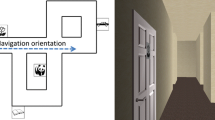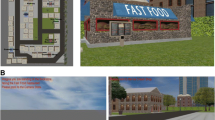Abstract
Relatively little is known about how people use the landmarks in their environment to learn routes. Landmarks are commonly regarded as associative cues—stimuli that enable recall of directional responses that lead closer to the navigator’s goal. We contrast the function of landmark as associative cue with that of a beacon—a landmark near enough to a goal that moving toward it leads the navigator closer to his or her goal. In five experiments, participants learned a route through a simple desktop virtual environment. In the first three experiments, routes were learned better when their landmarks served as beacons than as associative cues. Two additional experiments showed that the acquired route knowledge depends on the function that landmarks serve during learning. Beacon-based route knowledge is less enduring and relatively less likely to involve knowledge of directions in the environment than is the route knowledge formed from landmarks that serve as associative cues.
Similar content being viewed by others
References
Abelson, R. P., &Prentice, D. A. (1997). Contrast tests of interaction hypotheses.Psychological Methods,2, 315–328.
Anderson, J. R., &Bower, G. H. (1972). Recognition and retrieval processes in free recall.Psychological Review,79, 97–123.
Andrade, J., &Meudell, P. (1993). Is spatial information encoded automatically in memory?Quarterly Journal of Experimental Psychology,46A, 365–375.
Benhamou, S., Bovet, P., &Poucet, B. (1995). A model for place navigation in mammals.Journal of Theoretical Biology,173, 163–178.
Cheng, K., &Newcombe, N. S. (2005). Is there a geometric module for spatial orientation? Squaring theory and evidence.Psychonomic Bulletin & Review,12, 1–23.
Clark, S. E., &Shiffrin, R. M. (1992). Cuing effects and associative information in recognition memory.Memory & Cognition,20, 580–598.
Cohen, R., &Schuepfer, T. (1980). The representation of landmarks and routes.Child Development,51, 1065–1071.
Cornell, E. H., Heth, C. D., &Alberts, D. M. (1994). Place recognition and way finding by children and adults.Memory & Cognition,22, 633–643.
Ellis, N. R. (1990). Is memory for spatial information automatically encoded?Memory & Cognition,18, 584–592.
Ekstrom, R. B., French, J. W., Harman, H. H., &Dermen, D. (1976).Kit of factor-referenced cognitive tests. Princeton, NJ: Educational Testing Service.
Gallistel, C. R. (1990).The organization of learning. Cambridge, MA: MIT Press.
Hasher, L., &Zacks, R. T. (1979). Automatic and effortful processes in memory.Journal of Experimental Psychology: General,108, 356–388.
Heft, H. (1979). The role of environmental features in route-learning: Two exploratory studies of way-finding.Environmental Psychology & Nonverbal Behavior,3, 172–185.
Heft, H. (1996). The ecological approach to navigation: A Gibsonian perspective. In J. Portugali (Ed.),The construction of cognitive maps (pp.105–132). Dordrecht: Kluwer.
Heft, H. (1997). The relevance of Gibson’s ecological approach to perception for environment-behavior studies. In G. T. Moore, & R. W. Marans (Eds.),Advances in environment, behavior, and design: Vol. 4. Toward the integration of theory, methods, research, and utilization (pp. 71–108). New York: Plenum.
Hermer, L., &Spelke, E. (1996). Modularity and development: The case of spatial reorientation.Cognition,61, 195–232.
Hermer-Vazquez, L., Spelke, E. S., &Katsnelson, A. S. (1999). Sources of flexibility in human cognition: Dual-task studies of space and language.Cognitive Psychology,39, 3–36.
Hollingworth, H. L. (1913). Characteristic difference between recall and recognition.American Journal of Psychology,24, 533–544.
Humphreys, M. S. (1978). Item and relational information: A case for context independent retrieval.Journal of Verbal Learning & Verbal Behavior,17, 175–187.
Jansen-Osmann, P. (2002). Using desktop virtual environments to investigate the role of landmarks.Computers in Human Behavior,18, 427–436.
Kintsch, W. (1970). Models for free recall and recognition. In D. A. Norman (Ed.),Models of human memory. New York: Academic Press.
Kuipers, B. J., &Levitt, T. S. (1988). Navigation and mapping in largescale space.Artificial Intelligence Magazine,9(2), 25–43.
Learmonth, A. E., Nadel, L., &Newcombe, N. S. (2002). Children’s use of landmarks: Implications for modularity theory.Psychological Science,13, 337–341.
Learmonth, A. E., Newcombe, N. S., &Huttenlocher, J. (2001). Toddlers’ use of metric information and landmarks to reorient.Journal of Experimental Child Psychology,80, 225–244.
Lockhart, R. S., Craik, F. I. M., &Jacoby, L. (1976). Depth of processing, recognition and recall. In J. Brown (Ed.),Recall and recognition (pp. 75–102). London: Wiley.
Loomis, J. M., Klatzky, R. L., Golledge, R. G., &Philbeck, J. W. (1999). Human navigation by path integration. In R. G. Golledge (Ed.),Wayfinding: Cognitive mapping and other spatial processes (pp. 125–151). Baltimore: Johns Hopkins.
Lynch, K. (1960).The image of the city. Cambridge, MA: MIT Press.
Murdock, B. B., Jr. (1982). A theory for the storage and retrieval of item and associative information.Psychological Review,89, 609–626.
Myers, G. C. (1914). A comparative study of recognition and recall.Psychological Review,21, 442–456.
Naveh-Benjamin, M. (1987). Coding of spatial location information: An automatic process.Journal of Experimental Psychology: Learning, Memory, & Cognition,13, 595–605.
Naveh-Benjamin, M. (1988). Recognition memory of spatial location information: Another failure to support automaticity.Memory & Cognition,16, 437–445.
O’Keefe, J., &Nadel, L. (1978).The hippocampus as a cognitive map. Oxford: Oxford University Press, Clarendon Press.
Pouliot, S., &Gagnon, S. (2005). Is egocentric space automatically coded?Acta Psychologica,118, 193–210.
Presson, C. C., &Montello, D. R. (1988). Points of reference in spatial cognition: Stalking the elusive landmark.British Journal of Developmental Psychology,6, 378–381.
Ruddle, R. A., Payne, S. J., &Jones, D. M. (1997). Navigating buildings in “desk-top” virtual environments: Experimental investigations using extended navigational experience.Journal of Experimental Psychology: Applied,3, 143–159.
Save, E., &Poucet, B. (2000). Involvement of the hippocampus and associative parietal cortex in the use of proximal and distal landmarks for navigation.Behavioural Brain Research,109, 195–206.
Siegel, A. W., &White, S. H. (1975). The development of spatial representations of large-scale environments. In H. Reese (Ed.),Advances in child development and behavior (Vol. 10, pp. 10–55). New York: Academic Press.
Simon, J. R. (1969). Reactions towards the source of stimulation.Journal of Experimental Psychology,81, 174–176.
Thorndyke, P. W., &Goldin, S. E. (1983). Spatial learning and reasoning skill. In H. L. Pick & L. P. Acredolo (Eds.),Spatial orientation: Theory, research, and application (pp. 195–217). New York: Plenum.
Thorndyke, P. W., &Hayes-Roth, B. (1982). Differences in spatial knowledge acquired from maps and navigation.Cognitive Psychology,14, 560–589.
Tlauka, M., &Wilson, P. N. (1994). The effect of landmarks on routelearning in a computer-simulated environment.Journal of Environmental Psychology,14, 305–313.
Ward, S. L., Newcombe, N., &Overton, W. F. (1986). Turn left at the church, or three miles north: A study of direction giving and sex differences.Environment & Behavior,18, 192–213.
Author information
Authors and Affiliations
Corresponding author
Additional information
This research was partially supported by NIMH Grant MH068245 to D.W.
Rights and permissions
About this article
Cite this article
Waller, D., Lippa, Y. Landmarks as beacons and associative cues: Their role in route learning. Memory & Cognition 35, 910–924 (2007). https://doi.org/10.3758/BF03193465
Received:
Accepted:
Published:
Issue Date:
DOI: https://doi.org/10.3758/BF03193465




